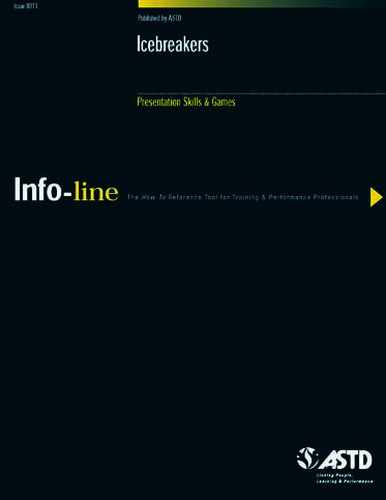Games
In addition to their usefulness as warm-ups and energizers, games are enjoyable ways to focus participants on the subject matter of the course.
Let's Make a Deal
Susan Boyd, president of a training consultant firm, suggests this game for fostering group interaction.
How to Use:
Divide the class into four-to eight-person teams.
Make up a worksheet listing six to eight items that each team's members would likely have with them, making one or two of the items more uncommon things. Suggestions include: a photo, a calculator, a pencil, more than three credit cards, an unusual key chain, something red, and so forth.
Life Map
Use this acquainter to help participants get to know one another by tracking the significant events in their lives.
From The Encyclopedia of Icebreakers by Sue Forbess-Greene, copyright Applied Skills Press, 1983.
Assign a recorder based on some criterion (for example, the person with the oldest car, whose birthday is next, who has the longest last name).
Teams get points for having each of the listed items—count only one of each item per person. The team with the most points wins and receives an award.
Jeopardy
Jim Leogue and John Macchi of JKL Associates (Coral Springs, FL) like to use a trainer-designed game similar to the popular Jeopardy television show as a way to begin the second session of a course (whether it is the beginning of the second day or the beginning of the afternoon). The questions for each session can be limited to the material covered in the previous session or can be a combination of material covered to date in the course, supplemented by material that generally should be known by the participants. For example, if the seminar is for company sales training, topics might include company products, the competition, and sales policies.
How to Use:
Before the session starts, glue 25 envelopes to poster board in a 5-by-5-inch matrix. Label each column with a subject heading and each row with a monetary value. Subject categories should stress the learning activity. Develop questions based on course material and enter the questions (and their answers) on 3-by-5-inch cards. (Remember that in Jeopardy, players are given the answers and have to provide the questions.) Assign dollar amounts to the questions based on their difficulty and insert the cards into the appropriate envelopes.
Divide the class into teams of equal numbers of participants, and have the team appoint a spokesperson—the only person who can give an answer. If another team member gives an answer, it is invalid.
Give each team play money to begin the game. The moderator should decide on the amount of money given to each team; that amount should be sufficient to ensure that bankruptcy is almost impossible, since bankruptcy removes a team from play. Allow an hour to complete the exercise to take advantage of the full value of the game and the team building that takes place.
Have a team begin by picking a question by category and dollar amount. They then have a minute to give their “question” to the “answer.” If the team answers correctly, they receive the dollar amount in play money. If they answer incorrectly or fail to answer, the next team is given a chance to answer the question. The question passes from team to team until a correct answer is given or until all teams pass. If a team answers the question incorrectly, they are penalized by giving the moderator the dollar amount of the question.
“Double Jeopardy” exists when the team selects a question that includes a wild card—a 3-by-5-inch card that doubles the dollar value of the question. One or two of these cards should be placed randomly on the playing board.
The game ends when all the questions have been answered. The team with the most money at the end of the game wins. A small reward as recognition is appropriate for winning team members, but the euphoria of winning and the camaraderie that builds during the game is the most rewarding aspect of this game. Moreover, the participants have had a fun—and challenging—review of course material.
Humor in IcebreakersSince humor is a basic communications tool, it can be of immeasurable value in an icebreaker. Humor is a right-brain, creative activity that can help trainers emphasize or reinforce main topics or points of discussion. Humor provides an entirely different perspective for an icebreaker. It can help relax people in tension-producing situations; it can be a “breath of fresh air” in activities that are encrusted with learned ritual and predictable patterns. It can even make a marginally interesting activity or subject more interesting, even exciting. Before forcing humor into a training activity, a word of caution is in order. As with any activity, any references to ethnicity, religion, politics, or gender should be avoided. Slapstick is also inappropriate. In any use of humor, participants must maintain their sense of personal dignity. People are more likely to risk humor if they can maintain their self-esteem. The appropriate use of humor in icebreakers, then, is important for the positive development of a group of trainees. It establishes an important norm for the duration of the training experience: Humor is fine. Learning is fun. The effectiveness of humor—throughout the course or within the icebreaker—is a function of many variables:
Attitudinal barriers may exist among the participants that hinder your efforts at injecting humor into icebreakers. Some of these are:
These attitudes can certainly hamper efforts to inject humor into an icebreaker, but they should not prevent the use of humor. Build the acceptance of humor as a norm through the use of the opening icebreaker, and these barriers are less likely to be problematic. Should a barrier rear its ugly head, the trainer can reiterate the value of humor or provide some positive feedback to the overly “serious” participant. |

